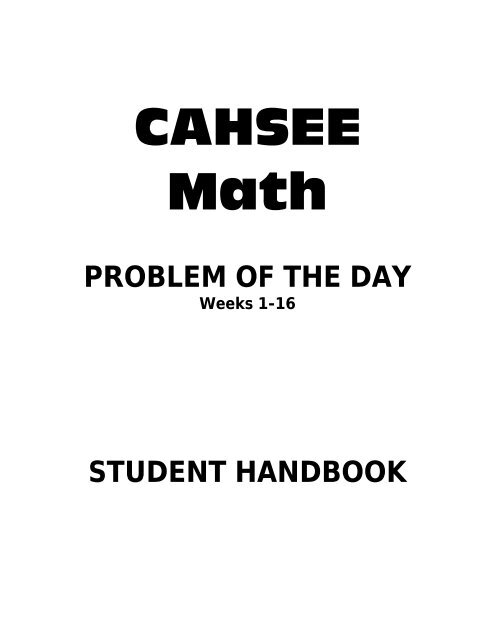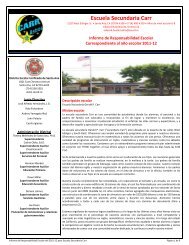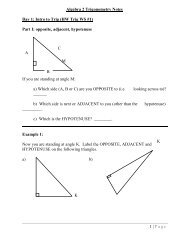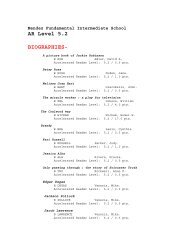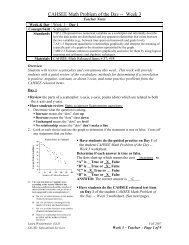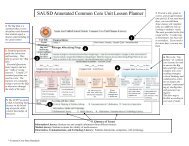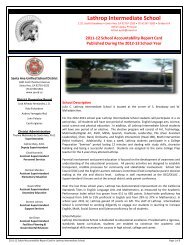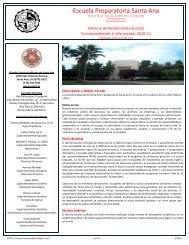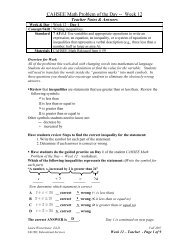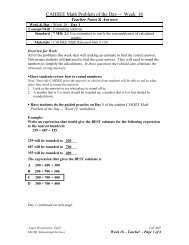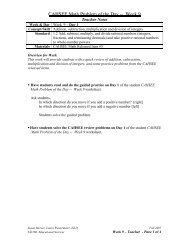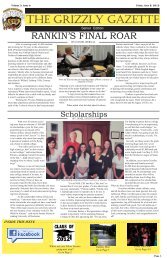Math POD Student Workbook
Math POD Student Workbook
Math POD Student Workbook
You also want an ePaper? Increase the reach of your titles
YUMPU automatically turns print PDFs into web optimized ePapers that Google loves.
CAHSEE<strong>Math</strong>PROBLEM OF THE DAYWeeks 1-16STUDENT HANDBOOK
SAUSD CAHSEE <strong>Math</strong> Problem of the Day -- Week 1Steps to find the mean (a.k.a. average.)1. Add all the numbers2. Divide by the number of numbersExample:Find the average of 10, 25, 20 and 5.Step 1: 10 + 25 + 20 + 5 = ______Step 2: 60 / 4 = ______Day 1(CAHSEE <strong>Math</strong> Released Item 35)Rico’s first three test scores in biology were65, 90, and 73. What was his mean score?A 65B 73C 76D 90ANSWER: The mean is _______.Steps to find the median (a.k.a. middle)1. Write the numbers in order fromsmallest to largest.2. Find the number in the middle. If thereare two numbers then find the averageof those two numbers.Example:Find the median of 14, 20, 12 and 10.Step 1: ____, ____, ____, ____Step 2: There are two numbers in the middle (12,14). Add 12 and 14 and divide by 2.ANSWER: The median is _____Steps to find the mode (a.k.a. mostpopular)1. Write the numbers in order fromsmallest to largest.2. Find the number that is written themost times.Example:Find the mode of 7, 8, 10, 4, 8, 5, 8, 7.Step 1: 4, 5, 7, 7, 8, 8, 8, 10Step 2: The number ____ occurs the most times.ANSWER: The mode is _____Day 2(CAHSEE <strong>Math</strong> Released Item 34)Donald priced six Compact Disc (CD) players.The prices are shown below...$21.00, $23.00, $21.00, $39.00, $25.00, $31.00..What is the median price?A $21.00B $24.00C $27.00D $30.00Day 3(CAHSEE <strong>Math</strong> Released Item 37)The box below shows the number of kilowatthoursof electricity used last month at each ofthe houses on Harris Street...620, 570, 570, 590, 560, 640, 590, 590, 580..What is the mode of these data?A 560B 580C 590D 640Laura Westermeier, Ed.D. Fall 2007SAUSD, Educational Services Week 1 – <strong>Student</strong> - Page 1 of 2
SAUSD CAHSEE <strong>Math</strong> Problem of the Day -- Week 1Day 4(SDCOE CAHSEE Prep: Mod 4 Day 6 P3 #2)Find the mean, median and mode of the following data set: 3, 3, 6, 4Day 5(CAHSEE <strong>Math</strong> Released Item 36)The chart below shows the mathematics test scores of three students.What is Hector’s mean score?A 6B 7C 8D 9Laura Westermeier, Ed.D. Fall 2007SAUSD, Educational Services Week 1 – <strong>Student</strong> - Page 2 of 2
SAUSD CAHSEE <strong>Math</strong> Problem of the Day - Week 2Steps to answer Bar Graph questions:1. Determine what the question is asking. Look forwords like true or false.2. Look at each choice and use the graph to determineif the statement is true or false. If looking for a truestatement then cross off any statements that arefalse. Also, look at the easiest statements first.Example:Day 1(CAHSEE <strong>Math</strong> Released Item 52 )Determine if each answer is true or false.A. Team 3 is the gray bars. In Year 1 they came in secondbut in Year 2 they came in third.“A” is __True or __ FalseB. Three calculations would need to be done to solve thisso let’s skip it and see if one of the other statements are true.C. In Year 4 Team 3 won more Team 1.“C” is ___True or ___ FalseD. Team 2 (black bars) did increase the number of winseach year so “D” is ___True or ___False.Since you have determined that either A, C, or D is true youdo not really need to do the calculation for B.ANSWER: The correct answer is _____.ANSWER:Laura Westermeier, Ed.D. Fall, 2007Educational Services, SAUSD Week 2 – <strong>Student</strong> - Page 1 of 5
SAUSD CAHSEE <strong>Math</strong> Problem of the Day - Week 2Steps to answer Line Graph questions:1. Determine what the question is asking. Look for wordslike previous which means compare the time before tothe time they are asking about.2. The slant or direction of the line tells you if there is anincrease (line slants up) or decrease (line slants down).3. Look at each choice and use the graph to determine if theanswer is true or false. Eliminate the obvious wronganswers first. There will only be one correct choice.Day 2 (CAHSEE <strong>Math</strong> Released Item 53)Example:Gas Prices$2.32$2.30$2.28$2.26$2.24$2.22$2.20$2.180 1 2 3 4 5 6WeekThe graph above represents the gas prices in San Diegoover a five-week period. Which week had the greatestincrease from the previous week?A. Week 2B. Week 3C. Week 4D. Week 5ANSWER:Determine if each answer is true or false.1. Increase means we are looking for a line that slants upfrom the week before to the week they are asking about.Which two answers can be eliminated: ____ and ____2.Which two answers show an increase because they slantup: _____ and _____3.Which of those two answers slant up the most? _____ANSWER: The greatest increase from the previous weekhappens in Week ____ so the correct answer is ______.Laura Westermeier, Ed.D. Fall, 2007Educational Services, SAUSD Week 2 – <strong>Student</strong> - Page 2 of 5
SAUSD CAHSEE <strong>Math</strong> Problem of the Day - Week 2Steps to answer Pie Chart questions1. Percents can be added just like regular numbers.2. A pie chart always adds up to 100%3. Do the math for each statement to see if the statement is true.Cross off any statement that is false.4. If there are not statements but just answers then you will needto make the calculation to determine the correct answer. Ifyou have the total and need to find a percent of that thenchange the percent to a fraction or decimal and multiply.Example:Day 3(CAHSEE <strong>Math</strong> Released Item 51)ANSWER:A. Romance and Science Fiction add up to %which is greater than % for Children’s“A” is ___ True or ____ FalseB. Children’s, Mysteries, and Art add up to _ __%which is half but not more than half.“B” is ____ True or ____ FalseC. Science Fiction and Art add up to __ % which ismore than __ % for Mysteries so C is ________.D. Romance, Mysteries, and Science Fiction add up to____ % which is more than half or 50%so D is __________.ANSWER: The correct answer is ______.Laura Westermeier, Ed.D. Fall, 2007Educational Services, SAUSD Week 2 – <strong>Student</strong> - Page 3 of 5
SAUSD CAHSEE <strong>Math</strong> Problem of the Day - Week 2Steps to answer Venn Diagramquestions1. Venn diagrams are made of two circles thatoverlap. Each circle contains the members of agroup. The part of the circles that overlap showthe members that are in both groups.2. Determine what the question is asking. Lookfor words like:• both meaning found in the space between thecircles• only meaning inside of one circle but notfound in the space between the circles• total means you need to add the number inthe circle and between the circles3. Look at each choice and use the Venn diagramto determine if the answer is true or false.Day 4 (CAHSEE <strong>Math</strong> Released Item #55)ANSWER:How many girls are only on the track team?A 6B 31C 37D 55A. The 6 refers to girls in __________ and_________ so A is __________.B. The 31 refers to girls that are only in_________ so B is ___________.C. The 37 refers to all of the girls in Trackincluding those in Soccer so C is ______.D. The 55 refers to all of the girls in Soccerand Track so D is ________.The correct answer is ________.Laura Westermeier, Ed.D. Fall, 2007Educational Services, SAUSD Week 2 – <strong>Student</strong> - Page 4 of 5
SAUSD CAHSEE <strong>Math</strong> Problem of the Day - Week 2Day 5 (CAHSEE <strong>Math</strong> Released Item #54)ANSWER: ____________Laura Westermeier, Ed.D. Fall, 2007Educational Services, SAUSD Week 2 – <strong>Student</strong> - Page 5 of 5
SAUSD CAHSEE <strong>Math</strong> Problem of the Day - Week 3<strong>Student</strong>Steps to answer Scattergram questions:1. Determine what the question is asking.• Increase means the “dots” slant up• Decrease means the “dots” slant down• Unchanged means the “dots” are level• No relationship means the “dots” don’t make a line2. Look at each choice and use the graph to determine ifthe statement is true or false. Cross off any statementsthat are false.Example:Day 1(CAHSEE <strong>Math</strong> Released Item #58 )ANSWER:Determine if each answer is true or false.The dots slant up which means the cost _________ so“A” is __True or __ False“B” is __True or __ False“C” is __True or __ False“D” is __True or __ FalseANSWER: The correct answer is _____.Laura Westermeier, Ed.D. Fall, 2007Educational Services, SAUSD Week 3 – <strong>Student</strong> - Page 1 of 6
SAUSD CAHSEE <strong>Math</strong> Problem of the Day - Week 3<strong>Student</strong>Day 2 - Steps to answer Quantitative Relationship questions:1. These questions ask you to compare the relationship between the data onthe x-axis (bottom) and y-axis (side).2. To find the answer draw a straight line up from the point on the x-axis to the line that shows thecorrelation.3. Then draw a straight line horizontally across to the y-axis to find the answer. There will only beone correct choice.Example:Find the correct answer:1. Draw a straight line up from the x-axis to theline that shows the correlation. The lineshould start between 100 and 150.2. Draw a straight line horizontally across fromthe correlation line to the y-axis.3. The answer is where the line crosses they-axis.ANSWER: The weight of a 120 man on theearth is ____________ pounds on the moon.The correct answer is _______Day 2 practice problem is on Page 3.Laura Westermeier, Ed.D. Fall, 2007Educational Services, SAUSD Week 3 – <strong>Student</strong> - Page 2 of 6
SAUSD CAHSEE <strong>Math</strong> Problem of the Day - Week 3<strong>Student</strong>Day 2 (CAHSEE <strong>Math</strong> Released Item #69)ANSWER: (Hint: The more hours Amy works the more she gets paid)The correct answer is _______Laura Westermeier, Ed.D. Fall, 2007Educational Services, SAUSD Week 3 – <strong>Student</strong> - Page 3 of 6
SAUSD CAHSEE <strong>Math</strong> Problem of the Day - Week 3<strong>Student</strong>Interpreting quantitative relationshipquestionsOne graph can have two correlations. The graph belowshows information for Car A and Car B.1. Find the answer for the first item.2. Find the answer for the second item.3. Subtract to find the difference.Example:Day 3(CAHSEE <strong>Math</strong> Released Item #67)ANSWER:Steps to find the answer:1. The x-axis shows the ____________ and they-axis shows the __________.2. Draw a vertical line up from the x-axis at the3 hour point to Car A. Then draw a line overto the y-axis. Car A went _________ miles.3. Draw a vertical line up from the x-axis at the3 hour point to Car B. Then draw a line overto the y-axis. Car B went _________ miles.4. The difference between Car A and Car B is_____ miles - ______ miles = ______ milesANSWER: The correct answer is ______.Laura Westermeier, Ed.D. Fall, 2007Educational Services, SAUSD Week 3 – <strong>Student</strong> - Page 4 of 6
SAUSD CAHSEE <strong>Math</strong> Problem of the Day - Week 3<strong>Student</strong>Steps to answer correlations that arepast the best fit line1. If there is no line or the line does not continue farenough you will need to finish drawing the line.Be sure to keep the line straight.2. From the x-axis draw a vertical line up to the linethat shows the correlation.3. From the correlation line draw a horizontal line tothe y-axis to determine the answer.Day 4 (CAHSEE <strong>Math</strong> Released Item #145)145. The graph below shows the value ofWhistler Company stock at the end of everyother year from 1994 to 200.From this graph, which of the following was themost probable value of Whistler Company stockat the end of 1992?A -$10B $1C $10D $20ANSWER:The correct answer is ________.Laura Westermeier, Ed.D. Fall, 2007Educational Services, SAUSD Week 3 – <strong>Student</strong> - Page 5 of 6
SAUSD CAHSEE <strong>Math</strong> Problem of the Day - Week 3<strong>Student</strong>Day 5 (CAHSEE <strong>Math</strong> Released Item #56)ANSWER: ____________Laura Westermeier, Ed.D. Fall, 2007Educational Services, SAUSD Week 3 – <strong>Student</strong> - Page 6 of 6
SAUSD CAHSEE <strong>Math</strong> Problem of the Day -- Week 4Step to convert fraction to decimalDivide the numerator by the denominatorSteps to convert decimal to percentMultiply the decimal by 100Day 1Find the decimal and percent equivalent of 2/5.Example: Find the decimal and percent equivalent of 3/4ANSWER: 1. 3 ÷ 4 = 0.752. 0.75 x 100 = 75%Steps to express part of a whole as afraction, decimal and percent1. to express as a fraction divide the part bythe whole. Simplify if possible.2. to express as decimal, use the fraction anddivide numerator by denominator3. to express as a percent, multiply thedecimal by 100.Example: Mary has $50, she spends $10 ongifts. What part of her money did she spend ongifts?ANSWER:1. to express as a fraction divide the part bythe whole: 10/502. simplify by dividing the numerator anddenominator by 10 10/50= 1/53. to express as a decimal: 1 ÷ 5 = 0.24. to express as a percent 0.2 x 100 = 20%Day 2Leslie and Kenny must travel 112 miles in order tovisit family. They will travel 56 miles by car. What partof the miles will be traveled by car?Express the answer as a fraction, decimal andpercent.Day 3David had $35. He spent $7. What part of his moneydid David spend?Express the answer as a fraction, decimal andpercent.Susan Mercer Fall, 2007Educational Services, SAUSD Week 4 – <strong>Student</strong> - Page 1 of 2
SAUSD CAHSEE <strong>Math</strong> Problem of the Day -- Week 4Day 432 out of 40 students in the class like to play basketball. What part of the students likes to play basketball?Express your answer as a fraction, decimal and percent.Day 5There are 16 animals in the aquarium, and 4 of them are frogs. What part of the animals are frogs?Express your answer as a fraction, decimal and percent.Susan Mercer Fall, 2007Educational Services, SAUSD Week 4 – <strong>Student</strong> - Page 2 of 2
SAUSD CAHSEE <strong>Math</strong> Problem of the Day -- Week 5Steps to find the percents1. Multiply the percent by the whole.2. Divide by 100.Day 1Find 15% of 240.Example: Find 50% of 120.1. multiply 120 by 50120 x 50 = 60002. divide 6000 by 1006000 ÷ 100 = 60ANSWER: 50% of 120 is 60.Steps to find the sale price of an item1. Multiply the regular price by the percent2. Divide the product by 1003. Subtract the answer from the originalprice.Day 2(CAHSEE <strong>Math</strong> Released Item 15 )A pair of jeans regularly sells for $24.00.They are on sale for 25% off. What is the saleprice of the jeans?Example: A $400 DVD player is on sale 30%off. What is the sale price of the DVD player?ANSWER:1. Multiply the price of the DVD player bythe percent.400 x 30 = 120002. Divide the product by 100. The answer isthe discount.12000 ÷ 100 = 120120 is the discount3. Subtract the discount from the originalprice of the DVD.$400 – $120 = $280Day 3(CAHSEE <strong>Math</strong> Released Item 16 )A CD player regularly sells for $80. It is onsale for 20% off. What is the sale price of theCD player?The discount price of the DVD player is$280Susan Mercer Fall, 2007Educational Services, SAUSD Week5 – <strong>Student</strong> - Page 1 of 2
Day 4(CAHSEE <strong>Math</strong> Released Item 17 )SAUSD CAHSEE <strong>Math</strong> Problem of the Day -- Week 5Jana bought a car for $4200 and later sold it for 30% profit. How much did Jana sell the car for?Day 5(CAHSEE <strong>Math</strong> Released Item 18)A) A salesperson at a clothing store earns a 2% commission on all the sales. How muchcommission does the salesperson earn on a $300 sale?B) A salesperson at a computer store earns a 15% commission on all the sales. How much commissiondoes the salesperson earn on a $900 sale?Susan Mercer Fall, 2007Educational Services, SAUSD Week5 – <strong>Student</strong> - Page 2 of 2
SAUSD CAHSEE <strong>Math</strong> Problem of the Day -- Week 6Solving problems with squares and circles:Always check to see what the question is asking.Look for words like:perimeter – distance around the outsidecircumference – the perimeter of a circleradius – distance from the center of a circle tothe sidediameter – distance from side to side of a circlethrough the center of a circle which is 2times the radius of a circle.The diameter of a circle is the same length as theside of a square in which it is inscribed.Steps to find the perimeter of a square ifgiven the radius of an inscribed circle:1. Find the length of one side of the square.(Since the radius is the distance from thecenter of the circle to the side, the radiusis ½ the length of the side of the square.To find the length of a side of the squaremultiply the radius by 2)2. Since the perimeter is the length aroundthe square add up the length of all 4 sidesor multiply the length by 4.Day 1(CAHSEE <strong>Math</strong> Released Item #104)104. In the figure above, the radius of theinscribed circle is 6 inches (in.) What is theperimeter of square ABCD?ABCD12π in.36π in.24 in.48 in.Example:...........................................In the figure above, the radius of the inscribedcircle is 2 inches. What is the perimeter of squareABCD?ANSWER:Find the length of the side of the square:Since the radius is ____ inches the length of theside of the square is 2 x ____ in. = ______ in.Find the perimeter of the square:____ in x 4 = _____ inLaura Westermeier, Ed.D. Fall, 2007Educational Services, SAUSD Week 1 – <strong>Student</strong> - Page 1 of 5
SAUSD CAHSEE <strong>Math</strong> Problem of the Day -- Week 6Steps to find the area of a rectangle:Multiply the length by the width:area of rectangle = length • widthThis formula works for all rectangles,including squares.Example:2 ftDay 2(CAHSEE <strong>Math</strong> Released Item #106)3 ftWhat is the area of the rectangle shownabove?ANSWER:First determine the length and the width.The length is _____ and the width and _____.Then put the numbers in the formula:area of rectangle = length • width________ =_____ • ______Steps to find the area of a triangle:Multiply ½ the length of the base by the height(distance from the base to the top) of thetriangle.area of triangle = ½ base • heightThis formula works for all triangles.Example:106. What is the area of the triangle shownabove?A 44 square unitsB 60 square unitsC 88 square unitsD 120 square units5 in4 in9 inWhat is the area of the triangle shown above?ANSWER:First determine the base and the height.The base is _____ and the height is ______.Then put the numbers in the formula:area of triangle = ½ base • heightarea of triangle = ½ _____ • ______area of triangle = _____Laura Westermeier, Ed.D. Fall, 2007Educational Services, SAUSD Week 1 – <strong>Student</strong> - Page 2 of 5
SAUSD CAHSEE <strong>Math</strong> Problem of the Day -- Week 6Steps to find the shaded area:1. Calculate the area of the whole rectangleor square: area = length x width2. Calculate the area of the cut out part.area of a circle = π x radius x radius3. Subtract the area of the cut out part fromthe area of the rectangle or square.Example:Day 3(CAHSEE <strong>Math</strong> Released Item 107)107. A rectangular pool 42 feet by 68 feet is ona rectangular lot 105 feet by 236 feet. Therest of the lot is grass. Approximately howmany square feet is grass?105. The largest possible circle is to be cutfrom a 10-foot square board. What will bethe approximate area, in square feet, ofthe remaining board (shaded region)?A 20B 30C 50D 80ANSWER:Calculate the area of the square:Area of square = ______ feet • ______ feetCalculate the area of the circle:Since the circle is fits exactly inside the squarethe length of the square is the same as thediameter of the circle. The radius of the circle is½ the diameter so the radius is _________ feet.Area of circle = π r 2Area of circle = 3.14 • ______ feet • ______ feetArea of circle = ______feet 2Subtract the area of the circle from thesquare:______ feet 2 - _______ feet 2 = _______ feet 2The correct answer is ______.Laura Westermeier, Ed.D. Fall, 2007Educational Services, SAUSD Week 1 – <strong>Student</strong> - Page 3 of 5
SAUSD CAHSEE <strong>Math</strong> Problem of the Day -- Week 6Steps to find the volume of a box:Multiply the length by the width by the height:volume of box = length • width • heightDay 4(CAHSEE <strong>Math</strong> Released Item # 108 )Example:3 cm4 cm2 cmWhat is the volume of the box shown above incubic centimeters (cm 3 )?ANSWER:First determine the length, width and height.The length is _____The width is _____The height is _____Then put the numbers in the formula and dothe calculation:volume of box = length x width x heightvolume of box = _____ • _____ • _____volume of box = ______108. What is the volume of the shoebox shownabove in cubic inches (in. 3 )?A 29B 75C 510D 675Laura Westermeier, Ed.D. Fall, 2007Educational Services, SAUSD Week 1 – <strong>Student</strong> - Page 4 of 5
SAUSD CAHSEE <strong>Math</strong> Problem of the Day -- Week 6Steps to find the surface area of a box: Day 5A box is composed of six surfaces:Top and bottomLeft side and right sideFront and backTo find the total surface area you need to add theareas of all six sides.Example:3 cm2 cm4 cmWhat is the surface area of the rectangleshown above in square centimeters (cm 2 )?ANSWER:The area of the bottom = ____ cm • ____ cmThe area of the bottom = _____ cm 2The top and the bottom are the same size.The total for top and bottom____ cm 2 + _____cm 2 = _____ cm 2The area of the right side = ____ cm • ____ cmThe area of the right side = ____ cm 2The right side and the left side are the same size.The total for right and left side____ cm 2 + _____cm 2 = _____ cm 2The area of the front = ____ cm • ____ cmThe area of the front = _____ cm 2The front and the back are the same size.The total for front and back____ cm 2 + _____cm 2 = _____ cm 2The total surface area of the box is_____ cm 2 + _____ cm 2 + _____ cm 2 = _____ cm 2(CAHSEE <strong>Math</strong> Released Item 118)118. Gina is painting the rectangular tool chestshown in the diagram below.If Gina paints only the outside of the toolchest, what is the total surface area, insquare inches (in. 2 ) she will paint?A 368B 648C 1296D 2880Laura Westermeier, Ed.D. Fall, 2007Educational Services, SAUSD Week 1 – <strong>Student</strong> - Page 5 of 5
SAUSD CAHSEE <strong>Math</strong> Problem of the Day -- Week 7Steps to find the area of a trapezoid:1. The question will usually give you the formula forfinding the area.2. Substitute the numbers into the formula• b 1 is the base• b 2 is the line that is parallel to the base• h is the height (the distance between the twoparallel lines)3. Solve the equation.Example:AB2What is the area, in square units, of trapezoid ABCDshown above?Area = ^h(b 1 +b 2 )ANSWER:The height is ______b 1 is ______37CDDay 1(CAHSEE <strong>Math</strong> Released Item 109 )109. What is the area, in square units, oftrapezoid QRST shown below?A 68B 104C 208D 960b 2 is ______Area = ^h(b 1 +b 2 )Area = ^_____(____+____)Area = ^___(_____)Area = ___(_____)Area = ____Laura Westermeier, Ed.D. Fall, 2007Educational Services, SAUSD Week 7 – <strong>Student</strong> - Page 1 of 5
SAUSD CAHSEE <strong>Math</strong> Problem of the Day -- Week 7Steps to find the area of an irregularfigure made of rectangles:1. Divide the figure into rectangles.2. Calculate the area of each rectangle.3. Add all the areas to find the total.Example:3222244What is the area, in square units, of the figure?22223Day 2(CAHSEE <strong>Math</strong> Released Item 114)114. In the figure below, every angle is aright angle.ANSWER:The area of a small rectangle:Area = Length • WidthArea = ____ • _____Area = _____The area of the large rectangle:Area = _____• ( ______ + _______ + _______)Area = _____ • (______)Area = ______The area of other small rectangle:Area = ____ • _____Area = ______Total are for all 3 rectangle:Area = ______ + ______ + _______Total area is __________What is the area, in square units, ofthe figure?A 96B 108C 120D 144Laura Westermeier, Ed.D. Fall, 2007Educational Services, SAUSD Week 7 – <strong>Student</strong> - Page 2 of 5
SAUSD CAHSEE <strong>Math</strong> Problem of the Day -- Week 7Steps to find the area of shaded areas ofa triangle:1. Determine the base and height of each triangle.2. Calculate the area of each triangle.3. Add the areas together to find the total.Day 3(CAHSEE <strong>Math</strong> Released Item #112 )Example:5 cm5 cmANSWER:Top triangle:Base = _______Height = ______Area = ½ base • heightArea = ½ ____ • _____Area = _______Bottom triangle:Base = _______Height = ______Area = ½ base • heightArea = ½ ____ • _____Area = ______5 cm 5 cmTotal area of Top triangle + Bottom triangleTotal of shaded area = _____ + ______Total of shaded area = ________Laura Westermeier, Ed.D. Fall, 2007Educational Services, SAUSD Week 7 – <strong>Student</strong> - Page 3 of 5
SAUSD CAHSEE <strong>Math</strong> Problem of the Day -- Week 7Steps to find the area of a figure withpart of it removed:1. Determine the area of the “whole” rectangle.2. Determine the area of the part that is missing.3. Subtract the part from the whole to find theremaining part.Example:(CAHSEE <strong>Math</strong> Released Item # 111 )Day 4(CAHSEE <strong>Math</strong> Released Item # 113 )113. A right triangle is removed from arectangle as shown in the figurebelow. Find the area of the remainingpart of the rectangle.A 40 in. 2B 44 in. 2C 48 in. 2D 52 in. 2Determine the area of the whole:Area = length • widthArea of whole = _____ • ______Area of whole = ______Determine the area of the part removed:The length is ________The width is 13 – (5+2) = ______Area of part removed = ______ • _______Area of part removed = ________The area of the figurearea = whole – partarea = _____ - _____area = _______Laura Westermeier, Ed.D. Fall, 2007Educational Services, SAUSD Week 7 – <strong>Student</strong> - Page 4 of 5
SAUSD CAHSEE <strong>Math</strong> Problem of the Day -- Week 7Steps to find the volume of an irregularobject made of prisms:1. Divide the object into prisms.2. Calculate the volume of each prism.3. Add all the volumes to find the total.Example:22 A1 B22 C1122221Day 5(CAHSEE <strong>Math</strong> Released Item 115)115. The short stairway shown below ismade of solid concrete. The heightand width of each step is 10 inches(in.). The length is 20 inches.What is the volume, in cubic units, of this object?Divide the object into prisms (A, B, and C).The volume of each piece = length • width • heightThe volume of prism A = ____ • ____ • _____The volume of prism A = _____The volume of prism B = ___ • (___ + ___ + ___ ) • ___The volume of prism B = ____ • _____ • _____The volume of prism B = _______The volume of prism C = ____ • ____ • _____The volume of prism C = _____The total volume = A + B + CThe total volume = _____ + ______ + _______The total volume = ______What is the volume, in cubic inches, ofthe concrete used to create thisstairway?A 3000B 4000C 6000D 8000Laura Westermeier, Ed.D. Fall, 2007Educational Services, SAUSD Week 7 – <strong>Student</strong> - Page 5 of 5
SAUSD CAHSEE <strong>Math</strong> Problem of the Day -- Week 8Day 1(CAHSEE <strong>Math</strong> Released Item 128)hypotenuseWhat is the value of x in thetriangle shown?x12 cmleg5 cmlegright angleSteps to find the hypotenuse of a rightangle triangle1. The hypotenuse is the longest side of aright angle triangle.2. Square each side.3. Add the squares.4. Find the square root.4 cmDay 2(CAHSEE <strong>Math</strong> Released Item 127 )N4 kmExample: Find the hypotenuse.3 cm1. find the longest side.2. square the sides of the right angletriangle3 x 3 = 94 x 4 = 163. add 9 and 169 + 16 = 254. find the square root of 2525 = 53 kmHomeThe club members hiked 3 kilometers northand 4 kilometers east, but then went directlyhome as shown by the dotted line. How fardid they travel to get home?ANSWER: the length of the missing side of thetriangle is 5 cm,Susan Mercer Fall, 2007Educational Services, SAUSD Week 8 – <strong>Student</strong> - Page 1 of 2
SAUSD CAHSEE <strong>Math</strong> Problem of the Day -- Week 8hypotenuseleglegright angleSteps to find the leg of a right angletriangleDay 3What is the value of x in the right angletriangle shown below?3 feetx5 feet1. Square the hypotenuse.2. Square the given leg.3. Subtract the square of thehypotenuse minus the square ofthe leg.4. Find the square root.Example: Find the missing leg.10 cm1. square 10 10 x 10 = 1002. square 8 8 x 8 = 643. subract 100 minus 64 100 – 64 = 364. find the square root of 3636 = 6ANSWER: the length of the missing side of thetriangle is 6 cm,x8 cmDay 4(CAHSEE <strong>Math</strong> Released Item 126 )What is the value of x in the right angletriangle shown below?5 feetx13 feet.Day 5(CAHSEE <strong>Math</strong> Released Item 129)In the drawing, the figure formed by the squares with sides that are labeledx, y and z is a right triangle.Which equation is true for all values of x, y and z?A x + y = zzB x 2 + y 2 = z 2C x 2 • y 2 = z 2D xy = zxyzSusan Mercer Fall, 2007Educational Services, SAUSD Week 8 – <strong>Student</strong> - Page 2 of 2
SAUSD CAHSEE <strong>Math</strong> Problem of the Day -- Week 9Steps to add integers using a number line.1. Draw a number line.2. Place the first number of the expression on thenumber line.3. Look at the sign of the next number, if thenumber is positive move that number of “steps”to the right; if the number is negative move thatnumber of “steps” to the left.4. Repeat step 3 for the next number.Example: Evaluate (–5) + 9Day 1Using a number line evaluate thefollowing expression:1. (–3) + 52. 10 + (–2) + (–4) + (–6)1. draw a number line2. place –5 on the number line3. move 9 “steps” to the right4. the answer is 4+9Steps to subtract integers.1. Copy the first number.2. Change the subtraction to addition3. Change the number after the subtraction to itsopposite.4. Add both numbers.Example: Evaluate (–5) – 41. Copy the first number (–5)2. Change the subtraction to addition3. Opposite of 4 is –44. Add (–5) + (–4)5. Answer –9Day 2Evaluate the following expression:1. 4 – 72. (–3) – (–10)3. 0 – 4 – 5Susan Mercer, Laura Westermeier, Ed.D. Fall, 2007Educational Services, SAUSD Week 9 – <strong>Student</strong> - Page 1 of 2
SAUSD CAHSEE <strong>Math</strong> Problem of the Day -- Week 9Steps to multiply and divide integers.Day 31. Multiply or divide both numbers2. If both numbers are positive or both numbersare negative the answer is positive3. If one number is positive and the other numberis negative then the answer is negative.Evaluate the following expressions:1. (–3) • (–6)Example: Evaluate (–5) • 42. (–4) • (–5) • (–2)1. Multiply both number 5 • 4 = 202. One number is positive (4) and one number isnegative (–5) so the answer is negative3. the answer is –20Day 4(Based on the CAHSEE <strong>Math</strong> Released Item 5)Which of the following numerical expression is a positive number?A. 5 + (–9)B. 0 – 12C. (–4) • (–3)D. 25 ÷ (–5)Day 5(Based on the CAHSEE <strong>Math</strong> Released Item 5)Which of the following numerical expression is a negative number?A. (–2) + 15B. (–10) – (–8)C. (–2) • (–2) • (–2) • (–2)D. (–100) ÷ (–25)Susan Mercer, Laura Westermeier, Ed.D. Fall, 2007Educational Services, SAUSD Week 9 – <strong>Student</strong> - Page 2 of 2
SAUSD CAHSEE <strong>Math</strong> Problem of the Day -- Week 10Lowest Common DenominatorThis week you will be working with fractions.When adding fractions you must make sure all ofthe denominators (number on the bottom of thefraction) are the same. To do this you must firstfind the Lowest Common Denominator orLCD. The LCD is the lowest number that both ofthe denominators can be divided into without aremainder.Steps to find the Lowest CommonDenominator:1. Factor each of the denominators intoprimes. (Prime factors are those numbersthat can only be divided by 1 orthemselves)2. Count the number of times each primenumber appears in each of thefactorizations3. For each prime number, take the largestof these counts.4. Write down that prime number as manytimes as you counted for it in step #35. The lowest common denominator is theproduct of all the prime numbers writtendown.In today’s problem you will be doing steps onethrough four:Example:What is the prime factored form of the lowestcommon denominator ofThe prime factors of 8 are _____ _____ _____The prime factors of 12 are _____ ____ _____The factored form of the Lowest CommonDenominator are _____ ______ ______ _____Day 1(CAHSEE <strong>Math</strong> Released Item #23 )23. Which of the following is the primefactored form of the lowest commondenominator ofA 5 x 1B 2 x 3 x 5C 2 x 5 x 3 x 5D 10 x 15Additional Practice:Which of the following is the prime factoredform of the lowest common denominator ofA 3 x 7B 3 x 3 x 7C 7 x 9D 21 x 9Laura Westermeier, Ed.D. Fall, 2007Educational Services, SAUSD Week 10 – <strong>Student</strong> - Page 1 of 5
SAUSD CAHSEE <strong>Math</strong> Problem of the Day -- Week 10Parts of a fraction:numerator (top) 1denominator (bottom) 3Day 2(CAHSEE <strong>Math</strong> Released Item # 22)22. Which fraction is equivalent to?Steps for adding fractions:1. Change the fractions so they each havethe lowest common denominator (steps 1-5 of Day 1) (Note: Remember to multiplythe numerator of each fraction by thesame number that you used to multiplythe denominator)2. Add the numerators to find the answer.(Do not add the denominators)3. Reduce the fraction to lowest terms byfinding an equivalent fraction in which thenumerator and denominator are as smallas possible.ABCDExample: What isThe Lowest Common Denominator is ______To change to the LCD multiply theAdditional PracticeWhich fraction is equivalent tonumerator and denominator both by ______.Doeshave the LCD? ________ARewrite the fractions with the LCD and add tofind the answer:+ =Can the answer be reduced? ________To reduce the fraction divide both the numeratorand denominator by _____Write the reduced fraction _______BCDLaura Westermeier, Ed.D. Fall, 2007Educational Services, SAUSD Week 10 – <strong>Student</strong> - Page 2 of 5
SAUSD CAHSEE <strong>Math</strong> Problem of the Day -- Week 10Steps for subtracting fractions:The steps for subtracting and adding fractionsare the same except you subtract on step 2.1. Change the fractions so they each havethe lowest common denominator (steps 1-5 of Day 1) (Note: Remember to multiplythe numerator of each fraction by thesame number that you used to multiply thedenominator)2. Subtract the numerators. (Do not subtractthe denominators)3. Reduce the fraction to lowest terms byfinding an equivalent fraction in which thenumerator and denominator are as smallas possible. To do this divide thenumerator and denominator by the samenumber.Day 3(CAHSEE <strong>Math</strong> Released Item # 24 )24. What isABCDExample: What is ?The Lowest Common Denominator is ______To changeto the LCD multiply thenumerator and denominator both by ______.Doeshave the LCD? ________Rewrite the fractions with the LCD and subtractto find the answer:- =Can the answer be reduced? ________The numerator and denominator each needs to bedivided by ______.Write the reduced fraction _______Laura Westermeier, Ed.D. Fall, 2007Educational Services, SAUSD Week 10 – <strong>Student</strong> - Page 3 of 5
SAUSD CAHSEE <strong>Math</strong> Problem of the Day -- Week 10Steps for fraction problems withparentheses:1. Do the parts of the problem inside theparentheses first.2. Once the answer is found for each partinside the parentheses then finish findingthe answer for the problem.Example: ( )+( ) =First find the answer for each part inside theparentheses:Day 4(CAHSEE <strong>Math</strong> Released Item # 4 )==__________________Now write the fraction for each parentheses:+What is the Lowest Common Denominator? ____Rewrite the problem with the Lowest CommonDenominator and then find the answer:+ =Can the answer be reduced? _________Laura Westermeier, Ed.D. Fall, 2007Educational Services, SAUSD Week 10 – <strong>Student</strong> - Page 4 of 5
SAUSD CAHSEE <strong>Math</strong> Problem of the Day -- Week 10Mixed numbers:An improper fraction is a fraction that has anumerator larger than or equal to its denominator.A proper fraction is a fraction with the numeratorsmaller than the denominator.A mixed number consists of an integer followedby a proper fraction.Changing an improper fraction to a mixednumber: The improper fraction 8/5 can bechanged to the mixed number 1 3/5 by dividingthe numerator (8) by the denominator (5). Thisgives a quotient of 1 and a remainder of 3. Theremainder is placed over the divisor (5).Changing a mixed number to an improperfraction: The mixed number 1 3/5 can bechanged to the improper fraction 8/5 bymultiplying the integer (1) by the denominator (5)and adding that to the numerator.Steps for multiplying fractions:1. Change any integers or mixed numbersback to improper fractions.2. Multiply the numerators and multiply thedenominators.3. Reduce the answer to lowest terms and, ifpossible, change back to a mixed number.Example:Mary uses 1 ½ cups of sugar to make a gallonof lemonade. How may cups of sugar does sheneed to make 2 gallons of lemonade?Write the equation to solve the problem:Day 5(CAHSEE <strong>Math</strong> Released Item #7)7. John uses ⅔ of a cup of oats per serving tomake oatmeal. How many cups of oatsdoes he need to make 6 servings?AB 4C2⅔5⅓D 9x= cups of sugar neededChange 1 ½ back to the mixed number: _______Change the integer to an improper fraction: ____Rewrite the equation and find the answer:x =Change the improper fraction to an integer ormixed number:Laura Westermeier, Ed.D. Fall, 2007Educational Services, SAUSD Week 10 – <strong>Student</strong> - Page 5 of 5
SAUSD CAHSEE <strong>Math</strong> Problem of the Day -- Week 11€€Powers to rememberb 4 = b • b • b • b1b = b−1€bb =1b 0 =1Steps to multiply and divide withpowers. €1. Write in expanded form.2. SimplifyDay 11. Simplify 7 3 • 7 4€2. Simplify (3 2 ) 4€€€Example 1: Simplify€4 3 • 4 21. Write in expanded form:2. 4 3 • 4 2 = 4 • 4 • 4 • 4 • 43. Simplify:4 3 • 4 2 = 4 • 4 • 4 • 4 • 4 = 4 5Example 2: Simplify€m • m €= m m • m m • m =1•1• m = m Day 2m 3 ÷ m 2m 3m = m • m • m2 m • m1. Write inexpanded form:2. Simplifym 3m = m • m • m21. Evaluate 5 2 • 5 4€2. Simplify€7 −6 • 7 4€Day 31. Simplify7a 2 b • 7bc 2€2. Simplify7x 2 z 2 • 8xz 3€Susan Mercer, Laura Westermeier, Ed.D. Fall, 2007Educational Services, SAUSD Week 11 – <strong>Student</strong> - Page 1 of 2
SAUSD CAHSEE <strong>Math</strong> Problem of the Day -- Week 11Absolute Value is the distance between zero andthe number. The symbol for absolute value is | |.Example: Evaluate |-7|1. On a number line find the distance between 0and –7.Day 4Using a number line find:1. absolute value of –9distance between0 and –7 is 72. absolute value of 53. absolute value of 0Day 5(CAHSEE <strong>Math</strong> Released Items 31, 32, 33)1. If |x| = 3, what is the value of x?A. –3 or 0B. –3 or 3C. 0 or 3D. –9 or 92. Which number has the greatest absolute value?A. –17B. –13C. 15D. 193. What is the absolute value of –4?A. –4B. –1/4C. 1/4D. 4Susan Mercer, Laura Westermeier, Ed.D. Fall, 2007Educational Services, SAUSD Week 11 – <strong>Student</strong> - Page 2 of 2
SAUSD CAHSEE <strong>Math</strong> Problem of the Day -- Week 12Day 1Changing statements into inequalitiesor equations: All of the problems this weekdeal with changing words into mathematicallanguage. You do not need to do any calculationor find the value for the variable. You will needto translate the words inside the “quotationmarks” into math symbols. In these questionsyou should also eliminate the obviously wronganswers.Inequalities are statements that use greater thanor less than. You will use the following symbols:< is less than≤ is less than or equal to> is greater than≥ is greater than or equal toOther symbols you need to know are:― decrease by+ increased bySteps to find the correct inequality:1. Write the symbol for each part of the statement.2. Determine if each answer is correct or wrong.Examples:Which of the following inequalities representsthe statement: (Write the symbol for each part)“A number, x, increased by 2 is greater than 24”______ _______ _______ _____Now determine which statement is correctA __ correct __ wrongB __ correct __ wrongC __ correct __ wrongD __ correct __ wrongThe correct ANSWER is ______.Day 1 <strong>POD</strong>(CAHSEE <strong>Math</strong> Released Item 59)59. Which of the following inequalitiesrepresents the statement “A number, x,decreased by 13 is less than or equal to 39”?ABCDAdditional Practice:Which of the following inequalities representsthe statement:“17 decreased by x is greater than or equal to 3”ABCDThe correct ANSWER is _________Laura Westermeier, Ed.D. Fall, 2007Educational Services, SAUSD Week 12 – <strong>Student</strong> - Page 1 of 5
Day 2SAUSD CAHSEE <strong>Math</strong> Problem of the Day -- Week 12Day 2 <strong>POD</strong>(CAHSEE <strong>Math</strong> Released Item # 61)Equalities are statements that have an equal sign.You can tell if a statement is an equality if it sayssomething is and gives a specific answer asopposed to something is greater than or less than.Steps to change a statement into anequality:1. Write the symbol for each part of the statement.If the statement says “number” substitute nWhere the statement says “is” put an =2. Determine if each answer is correct or wrong.Example:Multiply a number by 6 and add 2 to the result.61. Divide a number by 5 and add 4 to the result.The answer is 9.ABCDWhich of the following equations matchesthese statements?__________________The answer is 20.________Which of the following equations matchesthese statementsA 20=2n+6 __ correct __ wrongB (6+2)n=20 __ correct __ wrongC 6n=2 __ correct __ wrongD 6n+ 2=20 __ correct __ wrongThe correct ANSWER is ______.Additional Practice:Divide a number by 3 and add 7 to the result. Theanswer is 14.Which of the following equations matches thesestatements?ABCDThe correct ANSWER is _________Laura Westermeier, Ed.D. Fall, 2007Educational Services, SAUSD Week 12 – <strong>Student</strong> - Page 2 of 5
SAUSD CAHSEE <strong>Math</strong> Problem of the Day -- Week 12Day 3Steps to write an expression given awritten statement:1. Circle each part of the statement thatneeds to be used in the expression.2. Subtract if the item is used or sold3. Add if more of the item is received orboughtExample:The chef has x liters of cream. She uses 4 litersto make ice cream. The next day she used 3yliters to make a mousse. Which expressionrepresents the amount of cream she now has?A x+4+3yB x+4-3yDay 3 <strong>POD</strong>(CAHSEE <strong>Math</strong> Released Item 60 )60. A shopkeeper has x kilograms of tea in stock.He sells 15 kilograms and then receives a newshipment weighing 2y kilograms. Whichexpression represents the weight of the tea henow has?ABCDC x-4+3yD x-4-3yHow many liters does she start with? ______How many liters does she use first? ______Will you add or subtract? __________Cross off the ANSWERS can you eliminate.How many liters does she use next? ______Will you add or subtract? __________Cross off the ANSWER can you eliminate.The correct ANSWER is ______.Additional Practice:The donut maker has x dozen donuts. Hemakes 10 dozen more and then sells 6y dozen.Which expression represents the number ofdozens of donuts he now has?A x + 10 + 6yB x + 10 – 6yC x – 10 + 6yD x – 10 – 6yThe correct ANSWER is ______.Laura Westermeier, Ed.D. Fall, 2007Educational Services, SAUSD Week 12 – <strong>Student</strong> - Page 3 of 5
SAUSD CAHSEE <strong>Math</strong> Problem of the Day -- Week 12Day 4Many of the questions on the CAHSEE onlyrequire that you know how to write themathematical expression. You do not need to findthe answer or solve for x or y.Steps to write an expression usingthe distributive property: .1.Write the cost of one of the itemsa. Subtract if the amount is used or is lessb.Add if more of the amount is received oris more2.If more than one of the items is bought put theexpression from steps 1 in parentheses andmultiply by that number.EXAMPLE:At a fast food restaurant the combo meal that costx dollars can be super-sized for 1 dollar more.How many dollars does it cost to buy 5 supersizedcombo meals?A 5x-1B 5x+1C 5(x-1)D 5(x+1)How much does 1 super-size combo meal cost?______________How do you write 5 time the cost of one combomeal?____ (_____ + _____)Is 5x+1 the same as 5(x+1)? _______The correct ANSWER is ______.Day 4 <strong>POD</strong>(CAHSEE <strong>Math</strong> Released Item 63)63. At a local bookstore, books that normallycost b dollars are on sale for 10 dollars off thenormal price. How many dollars does it costto buy 3 books on sale?ABCDLaura Westermeier, Ed.D. Fall, 2007Educational Services, SAUSD Week 12 – <strong>Student</strong> - Page 4 of 5
SAUSD CAHSEE <strong>Math</strong> Problem of the Day -- Week 12Day 5Use the strategies for writing mathematical expressions from this week to find the correct answer:Example:In a classroom, the number of boys, b, is equal to 2 times the number of girls, g._________ _____ _________________Which equation matches the information?ABC2 • g = b2 • b = g2 • b = 2 • gD b • g = 2The correct ANSWER is ______.Day 5 <strong>POD</strong>(CAHSEE <strong>Math</strong> Released Item 62 )62. In a certain room, the number of chairs, c, is equal to 3 times the number of tables, t.Which equation matches the information?A 3 • c = tB 3 • t = cC 3 • c = 3 • tD c • t =3Laura Westermeier, Ed.D. Fall, 2007Educational Services, SAUSD Week 12 – <strong>Student</strong> - Page 5 of 5
SAUSD CAHSEE <strong>Math</strong> Problem of the Day -- Week 13Steps to find/calculate a probability1. Find the number of possible outcomes.2. Find the number of favorable events.3. Write as a fractionDay 1Anna has the letter tiles below in a bag.1) If Anna randomly selects a tile from the bag,what is the probability she will select a C?Example 1: If you role a number cube, what isthe probability of rolling a 5?1. All possible outcomes when rolling a dieare 1, 2, 3, 4, 5, 6 six in total2. Favorable event: rolling a number 5 one in total3. Probability of rolling a 5 is 1 out of six or1/6.2) If Anna randomly selects a tile from the bag,what is the probability she will select a T?The probability of rolling a 5 is 1/6.One out of six.Example 2: If you roll a number cube, what isthe probability of rolling an even number?1. All possible outcomes when rolling a dieare 1, 2, 3, 4, 5, 6 six in total2. Favorable event: rolling an even number2, 4, or 6 three in total3. Probability of rolling an even number is 3out of 6 or 3/6 =Day 2Fran has 16 Cds in a box; 6 country, 6 rock, 2dance, and 2 classical.1) If she takes out one CD without looking, whatis the probability that she will pick a danceCD?The probability of rolling a 5 is 1/6.One out of six.2) If she takes out one CD without looking, whatis the probability that she will pick a rock orcountry CD?Susan Mercer, Laura Westermeier, Ed.D. Fall, 2007Educational Services, SAUSD Week 11 – Answer Key - Page 1 of 2
SAUSD CAHSEE <strong>Math</strong> Problem of the Day -- Week 13Day 3A bucket contains 3 bottles of apple juice, 2 bottles of orange juice, 6 bottles of tomato juice, and 8bottles of water. If Kira randomly selects a bottle, what is the probability that she will select adrink other than water?31181a. b. c. d.419194€€€€Day 4The spinner shown to the right is fair. What is the probability that thespinner will not stop on red if you spin it one time?113a. b. c. d.43443€€€€Day 5Mr. Gulati is holding five cards numbered 1 through 5. He has asked five students to eachrandomly pick a card to see how goes first in a game. Whoever picks the card numbered 5 goesfirst. Juanita picks first, gets the card numbered 4, and keeps the card. What is the probabilitythat Yoko will get the card numbered 5 is she picks second?111a. b. c. d.23415€€€€Susan Mercer, Laura Westermeier, Ed.D. Fall, 2007Educational Services, SAUSD Week 11 – Answer Key - Page 2 of 2
SAUSD CAHSEE <strong>Math</strong> Problem of the Day -- Week 14Day 1Solving rate problems: All of theproblems this week deal with solving rateproblems. Rate problems involve time andeither distance or other quantities. In the questionfor Day 1 you are given the distance and rate ofspeed (miles per hour) and asked to find out howmuch time it takes to cover the distance. To findthe time you will need to divide the distance bythe rate. In these questions you can alsoeliminate the obviously wrong answers bymultiplying the answers by the rate to see if youget the distance given in the problem.Steps to solve a rate problem:1. In your own words write what the question isasking you to find out.2. Write the equation needed to find the answer.3. Check to make sure the units cancel out so theanswer is in the correct units.4. Reduce the fraction to find the answer.Examples: Jose drove 10 miles on the highwayat the speed of 30 miles per hour. How longdid it take him to drive that distance?What is the question asking you to find out:______________________________________Write the equation to find the answer:<strong>Student</strong> WorksheetDay 1 <strong>POD</strong>(CAHSEE <strong>Math</strong> Released Item #101)101. Beverly ran six miles at the speed of fourmiles per hour. How long did it take her torun that distance?Additional Practice:Ely rode her bike four miles at a speed of six milesper hour. How long did it take her to ride thatdistance?. 10 miles .30 miles/hourtime to drive 10 milesCancel the units. Note: if the unit is in thedenominator of the fraction in the denominator ofthe equation that is the same as multiplying thenumerator by that unitRewrite the equationThe correct ANSWER is _________. .Reduce the fraction as neededThe correct ANSWER is ______.Laura Westermeier, Ed.D. Fall, 2007Educational Services, SAUSD Week 14 – <strong>Student</strong> - Page 1 of 5
Day 2SAUSD CAHSEE <strong>Math</strong> Problem of the Day -- Week 14<strong>Student</strong> WorksheetDay 2 <strong>POD</strong>(CAHSEE <strong>Math</strong> Released Item # 100)For Day 2 you will be changing types of unitsfor a specific rate.100. Sixty miles per hour is the same rate aswhich of the following?Steps to change the units:1. Write the original units for the rate as a fraction2. Multiply by the fraction(s) for the conversion:AB1 mile per minute1 mile per second60 minutes 60 seconds1 hour 1 minute. 1 hour . . 1 minute .60 minutes 60 seconds3. Cancel the units that are in both the numeratorand denominator.Example: Thirty feet per second is the samerate as how many feet per minute?C6 miles per minuteD 360 miles per secondAdditional Practice:Driving 72 miles per hour is the same rate aswhich of the following?Write the original units for the rate as a fraction:A.02 miles per secondfeetsecondMultiply by the fraction that will change theseconds to minutes:B .2 miles per secondC 4320 miles per secondD 50400 miles per secondfeetsecondxsecondsminuteDo the calculation and cancel out the units to findthe answer:feetminuteThe correct ANSWER is _____feet per minute.Laura Westermeier, Ed.D. Fall, 2007Educational Services, SAUSD Week 14 – <strong>Student</strong> - Page 2 of 5
SAUSD CAHSEE <strong>Math</strong> Problem of the Day -- Week 14<strong>Student</strong> WorksheetDay 3For Day 3 you will solve word problems thatinvolve calculating the amount of somethingthat is done over a period of time.Steps to solve other rate problems:1. Read the question then circle what you arebeing asked to find.2. Circle the data you will use to find theanswer.3. Decide if you will multiply or divide tofind the answer then write the equation.4. Do the calculation.Example:Jorge can make four hamburger patties out ofone pound of meat. If he has five pounds ofmeat how many patties can he make?First, circle what you are being asked to find andwrite it below:Day 3 <strong>POD</strong>(CAHSEE <strong>Math</strong> Released Item #102 )102. Marcus can type about 42 words perminute. If he types at this rate for 30 minuteswithout stopping, about how many words willhe type?A 1260B 2100C 2520D 4200Second, circle the data you will use to find theanswer.Will you multiply or divide to find the answer?_______________Write the equation you need to find the answer:(make sure the units cancel out correctly)Additional Practice:Susan made 72 cookies. If she packs one dozen ina bag how many bags of cookies can she make?A 3B 5C 6Do the calculation.The correct ANSWER is ______.D 7Laura Westermeier, Ed.D. Fall, 2007Educational Services, SAUSD Week 14 – <strong>Student</strong> - Page 3 of 5
Day 4SAUSD CAHSEE <strong>Math</strong> Problem of the Day -- Week 14For Day 4 you will continue to practiceproblems that deal with rate. Use the samestrategies you used on Day 3. Be sure to look atthe units involved and convert to the correctunits to find the answer.<strong>Student</strong> WorksheetDay 4 <strong>POD</strong>(CAHSEE <strong>Math</strong> Released Item #103 )103. A landscaper estimates that landscaping a newpark will take 1 person 48 hours. If 4 peoplework on the job and they each work 6 hourdays, how many days are needed to completethe job?Example:There are 12 feet of ribbon in a roll. If youwant to cut 18 pieces of ribbon that are each24 inches long, how many rolls of ribbon willyou need?What units will the answer be in? _________A 2B 4C 6D 8Write the equation you will use to find out howlong the total ribbon will be in inches:Change the total length into feet:Now find how many rolls of ribbon you willneed:The answer is ____________.Laura Westermeier, Ed.D. Fall, 2007Educational Services, SAUSD Week 14 – <strong>Student</strong> - Page 4 of 5
SAUSD CAHSEE <strong>Math</strong> Problem of the Day -- Week 14<strong>Student</strong> WorksheetDay 5Use the strategies for solving rate problems from this week to determine the information that isneeded find the correct answer:Day 5 <strong>POD</strong>(CAHSEE <strong>Math</strong> Released Item # 133)A flower shop delivery van traveled thesedistances during one week:104.4, 117.8, 92.3, 168.7, and 225.6 miles.How many gallons of gas were used bythe delivery van during this week?133. What other information is needed in orderto solve this problem?A The average speed traveled in miles perhourB The cost of gasoline per gallonCThe average number of miles per gallon forthe vanD The number of different deliveries the vanmadeAdditional Problem for Day 5(CAHSEE <strong>Math</strong> Released Item # 134)134. A shipping company has 25 offices that shipped60,000 packages last week. The offices wereopen 6 days and used 80,000 kilowatt-hours ofelectricity. Which pieces of information givenabove are necessary to find the average numberof packages shipped per day last week?ABCDthe number of offices and the number ofpackagesthe number of packages and the amountof electricity usedthe number of packages and the numberof days open during the weekthe number of days open during the weekand the amount of electricity usedLaura Westermeier, Ed.D. Fall, 2007Educational Services, SAUSD Week 14 – <strong>Student</strong> - Page 5 of 5
SAUSD CAHSEE <strong>Math</strong> Problem of the Day -- Week 15<strong>Student</strong> WorksheetDay 1 - Working with measurements: (Day 1 has two pages)All of the problems this week deal with converting values in a measurement system (inches to feet,centimeters to meters) and converting values from one measurement system to another. The questionsalso give you more practice eliminating the obviously wrong answers.Metric System• The prefixes commonly used in the Metric System are:o kilo – 1000o centi – 1/100 or .01o milli – 1/1000 or .001Steps to change size of the units in the Metric System:1. Draw a number line for the Metric System.2. Write the number of units you have under the number that corresponds with the unit.3. Count how many moves it takes to get to the new unit.RULE: To find the conversion factor, use the number 1 and a zero for each move you make to theright or left.4. Multiply or divide the original number by the conversion factor.RULE: When moving to the right, DIVIDE by the conversion factor.When moving to the left, MULTIPLY by the conversion factor.Example: Seven meters is –ABCDof a kilometerof a kilometer70 kilometers7000 kilometers1. Start by drawing a number line for the Metric System and writing 7 under the meters place. Thencount how many moves it takes to get to the meters place..001 .01 .1 1 10 100 1000milli centi deci deci hecto kilo71 2 3Since you had to move to the __________ you will need to _____________ by ____________.The correct ANSWER is ______.Laura Westermeier, Ed.D. Fall, 2007Educational Services, SAUSD Week 15 – <strong>Student</strong> - Page 1 of 6
Day 1 <strong>POD</strong> (page 2)(CAHSEE <strong>Math</strong> Released Item 93)93. One millimeter is—SAUSD CAHSEE <strong>Math</strong> Problem of the Day -- Week 15<strong>Student</strong> WorksheetABCDof a meterof a meter100 meters1000 metersAdditional practice for Day 11. One kilometer is—ABCDof a centimeter100 centimeters1000 centimeters100000 centimeters2. Three centimeters is ____ABCDof a millimeter30 millimeters300 millimeters3000 millimetersLaura Westermeier, Ed.D. Fall, 2007Educational Services, SAUSD Week 15 – <strong>Student</strong> - Page 2 of 6
SAUSD CAHSEE <strong>Math</strong> Problem of the Day -- Week 15<strong>Student</strong> WorksheetDay 2 – Changing between Englishand Metric Systems• The units used for distance in the Englishsystem are:o 12 inches = 1 footo 3 feet = 1 yard• If you are asked to convert from the Englishsystem to the Metric system or Metricsystem to English system you will be giventhe conversion factor.Example: 1 meter ≈ 39 inches means that onemeter is approximately 39 inches.Steps to changebetween English and Metric:1. To find out how many inches something thatis measured in meters, multiply the number ofmeters by 39.2. If they need to change the answer to feet andinches they would divide by 12 to find thefeet and the remainder is the number ofinches left over.Note: In questions like these you can ofteneliminate the wrong answers by estimating theanswer. Since a meter is just over 3 feet long youcan divide the number of meters by 3 to find theapproximate number of feet. Any answer that isless can be eliminated.Example: A wall is 5 meters long. About howlong is the wall in feet (ft) and inches (in)?(1 meter ≈ 39 inches)A 12 ft 6 inB 14 ft 8 inC 16 ft 3 inD 18 ft 2 inWhich two answers can be eliminated becausethey are less than 5 x 3 (there are about 3 feetin a meter) _______ and ______How many inches are in 5 meters:5 x _____ = ______To find how many feet divide the inches by ___The number of feet is _____ so answer ____ istoo long.The correct ANSWER is ______.Day 2 <strong>POD</strong>(CAHSEE <strong>Math</strong> Released Item # 94)94. A boy is two meters tall. About how tall is theboy in feet (ft) and inches (in.)?(1 meter ≈ 39 inches)Laura Westermeier, Ed.D. Fall, 2007Educational Services, SAUSD Week 15 – <strong>Student</strong> - Page 3 of 6ABCD5 ft 0 in.5 ft 6 in.6 ft 0 in.6 ft 6 in.Additional Practice for Day 2:(CAHSEE <strong>Math</strong> Released Item # 96)96. If Jill is driving at 65 miles per hour,what is her approximate speed in kilometersper hour? ( 1 mile ≈ 1.6 kilometers)A 16B 41C 104D 173
SAUSD CAHSEE <strong>Math</strong> Problem of the Day -- Week 15<strong>Student</strong> WorksheetDay 3– Changing between units oftimeThe units used for time are:o 60 seconds = 1 minuteo 60 minutes = 1 houro 24 hours = 1 daySteps to change time from one unit toanother:1. Circle the unit you are starting with andending with.2. Multiply if you are going from largerunits to smaller units. Divide if you aregoing from smaller units to larger units.Day 3 <strong>POD</strong>(CAHSEE <strong>Math</strong> Released Item #95 )95. Juanita exercised for one hour. How manyseconds did Juanita exercise?A 60B 120C 360D 3,600Example:Julia did homework for 240 minutes. How manyhours did Julia do homework?The unit of time you are starting with is _______.The unit you are changing to is _________.To do this you will need to _______ 240 by ____.. 240 .Additional Practice for Day 3:A television show covers a time period of86400 seconds. How many hours does the showcover?ABC1 hour24 hours48 hoursThe correct ANSWER is ______.D60 hoursLaura Westermeier, Ed.D. Fall, 2007Educational Services, SAUSD Week 15 – <strong>Student</strong> - Page 4 of 6
SAUSD CAHSEE <strong>Math</strong> Problem of the Day -- Week 15<strong>Student</strong> WorksheetDay 4Steps to find the area when givendifferent units:1. Circle the unit the answers are in.2. Change all the units given in the problem tothe unit that the answer is given in.3. Multiply to find the area.EXAMPLE:The width of the rectangle shown below is4 feet (ft). The length is 24 inches (in).Day 4 <strong>POD</strong>(CAHSEE <strong>Math</strong> Released Item #119 )119. The width of the rectangle shown below is6 inches (in.). The length is 2 feet (ft).What is the area of the rectangle in squareinches?A 122 ft6 in.4 ft.B 16C 6024 in.D 144What is the area of the rectangle insquare feet?The units for the answer are __________.To change 24 in. to feet you will _______ by ___24 in = ______ ftTo find the area of the rectangle in ft:_____ ft x _____ ft = _______ square feetThe correct ANSWER is ______.Additional Practice for Day 4:The width of the rectangle shown below is1 yard. The length is 2 feet (ft).2 feet1 yardWhat is the area of the rectangle in squareinches?A 72B 576C 864D 2400Laura Westermeier, Ed.D. Fall, 2007Educational Services, SAUSD Week 15 – <strong>Student</strong> - Page 5 of 6
SAUSD CAHSEE <strong>Math</strong> Problem of the Day -- Week 15<strong>Student</strong> WorksheetDay 5Use the strategies from this week to find the correct answer:Day 5 <strong>POD</strong>(CAHSEE <strong>Math</strong> Released Item # 121 )121. A rectangular field is 363 feet long and 240feet wide. How many acres is the field?(1 acre = 43,560 square feet)A 2B 3C 4D 5Additional Practice for Day 5(CAHSEE <strong>Math</strong> Released Item # 120 )120. One cubic inch is approximately equal to16.38 cubic centimeters. Approximately howmany cubic centimeters are there in 3 cubicinches?A 5.46B 13.38C 19.38D 49.14Laura Westermeier, Ed.D. Fall, 2007Educational Services, SAUSD Week 15 – <strong>Student</strong> - Page 6 of 6
SAUSD CAHSEE <strong>Math</strong> Problem of the Day -- Week 16Day 1Estimating the correct answer: All ofthe problems this week deal with making anestimate to find the correct answer. This meansyou will not need to find the exact answer. Youwill need to round the numbers to simplify thecalculations. In these questions you should alsoeliminate the obviously wrong answers.Steps to rounding numbers:Note: Since the CAHSEE gives you answers to choosefrom you will be able to tell to what place you need toround the answers.1. Look at the answers to see what place toround off to.2. A number that is 5 or more should be roundedup; a number that is 4 or less should berounded down.Example:Write an expression that would give the BESTestimate for the following expression to thenearest hundred:239 + 687 + 355Day 1 <strong>POD</strong>(CAHSEE <strong>Math</strong> Released Item # 139)139. The table below shows the number ofvisitors to a natural history museum duringa 4-day period.Day Number of VisitorsFriday 597Saturday 1115Sunday 1346Monday 365Which expression would give the BESTestimate of the total number of visitorsduring this period?A 500 + 1100 + 1300 + 300B 600 + 1100 + 1300 + 300C 600 + 1100 + 1300 + 400D 600 + 1100 + 1400 + 400239 will be rounded to _______687 will be rounded to _______355 will be rounded to _______The expression that gives the BEST estimate isA 200 + 600 + 300B 200 + 700 + 300C 200 + 700 + 400D 300 + 700 + 400Laura Westermeier, Ed.D. Fall, 2007Educational Services, SAUSD Week 15 – <strong>Student</strong> - Page 1 of 3
Day 2SAUSD CAHSEE <strong>Math</strong> Problem of the Day -- Week 16Day 2 <strong>POD</strong>(CAHSEE <strong>Math</strong> Released Item # 140)When doing estimates for multiplication, look atthe answers provided to determine which placethe problem needs to be rounded to. Forexample, if there is only one digit in the answerbesides 0 then the numbers multiplied need to berounded so they only have one digit.140. Which is the best estimate of 326 x 279?A 900B 9,000C 90,000Example:Which is the best estimate of 189 x 32?D 900,000A 600B 6,000C 60,000D 600,000First, look at the answers. How many digitsbesides 0 are in the answer: _____The 189 should be rounded to ________The 32 should be rounded to _______The correct ANSWER is ______.Laura Westermeier, Ed.D. Fall, 2007Educational Services, SAUSD Week 15 – <strong>Student</strong> - Page 2 of 3
SAUSD CAHSEE <strong>Math</strong> Problem of the Day -- Week 16Days 3-5 Use the estimation strategies from Day 1 and 2 to find the answers.Day 3 <strong>POD</strong>(CAHSEE <strong>Math</strong> Released Item # 143 )143. Sally paid $1.89 for 5 plums. About how many plums would she get for $10?A 4B 5C 10D 25Day 4 <strong>POD</strong>(CAHSEE <strong>Math</strong> Released Item # 142 )142. The temperature on a mountain peak was 7 degrees Fahrenheit (°F) at 6:00 p.m. By 8:00p.m., the temperature had dropped to 0°F. If the temperature continued to drop at aboutthe same rate, which is the BEST estimate of the temperature at 11:00 p.m.?ABCD-20°F-14°F-10°F-9°FDay 5 <strong>POD</strong>(CAHSEE <strong>Math</strong> Released Item # 141 )141. Marcus plans to buy a CD that has a regular price of $13.99. It is on sale for 10% off, butMarcus will have to pay 7% sales tax. Which is the MOST reasonable estimate of the totalcost of the CD including tax?A $12.50B $13.50C $14.50D $15.50Laura Westermeier, Ed.D. Fall, 2007Educational Services, SAUSD Week 15 – <strong>Student</strong> - Page 3 of 3


